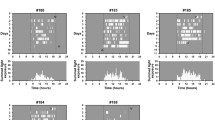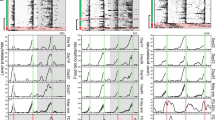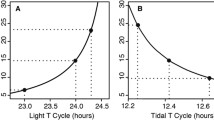Summary
-
1.
In thefirst part of the paper, the model of non-parametric entrainment of circadian pacemakers is tested for the case of nocturnal rodents. The model makes use of the available data on freerunning period (τ) in constant darkness (Pittendrigh and Daan, 1976a) and on phase response curves (PRC) for short light pulses (Daan and Pittendrigh, 1976a). It is tested in experiments using 1 or 2 light pulses per cycle.
-
2.
Mesocricetus auratus andPeromyscus leucopus entrain to Zeitgebers involving 1 pulse (15′ or 60′) per cycle. The phase angle differences between rhythm and light cycle depends on the periods (τ andT) as predicted by the model. Entrainment ofP. leucopus is unstable due to the after effects on τ created by the light pulse.
-
3.
The limiting values of zeitgeber period to which the animals entrain are much closer to 24 h than inDrosophila pseudoobscura, as the model predicts. However, frequent failures to entrain toT=23 andT=25 h are only explained if we take considerable interindividual variation in both τ and PRC into account.
-
4.
With 2 pulses per cycle, the model predicts that entrainment will be more stable when activity is in the longer interval between the pulses than when it is in the shorter interval. This is true in the experimental data, where the phase relationships match predictions for skeleton photoperiods up to ca. 14 h. Increasing asymmetry forces animals into a “phase jump”, so that activity shifts from the shorter to the longer interval. Theseψ-jumps are accurately predicted in the hamster, but they occur at much longer photoperiods than predicted inP. leucopus.
-
5.
Thus, the unqualified model, using a rigidly fixed species τ and PRC, is surely inadequate to explain entrainment. The extent to which variations in τ and PRC-shape, both “spontaneous” and induced by the entrainment process, can be known or inferred restricts the validity of the predictions. Yet we conclude, from a good deal of agreement between experiment and prediction (i), from the close correspondence between complete and skeleton photoperiods (ii), and on behavioural grounds (iii), that non-parametric entrainment by short light signals has a major share in the entrainment of nocturnal rodent rhythms in nature.
-
6.
With these restrictions in mind, we analyse in thesecond part of the paper how the empirical regularities concerning τ and PRC, and reported earlier (Pittendrigh and Daan, 1976; Daan and Pittendrigh, 1976a, b), contribute to the stabilization of the phase angle difference (ψ) between the pacemaker and the external world. Use is made of computer simulations of artificial pacemakers with variable τ and PRC.
-
7.
ψ is most sensitive to instabilities in τ when\(\bar \tau \) is close to 24 h. Thus the verycircadian nature of these pacemakers helps to conserveψ. Selection pressure for homeostasis ofτ has been large in a species (M. auratus) where\(\bar \tau \)=24 h. The effect ofψ-instability is further reduced by entrainment with 2 pulses (dawn and dusk), made possible by the PRC's having both an advance and a delay section.
-
8.
To analyze the contributions toψ-conservation with seasonally changing photoperiod, we have assumed that it is of functional significance to conserve the phase of activity with respect to dusk (nocturnal animals) or to dawn (diurnal animals). We distinguish three contributions of nocturnal pacemaker behaviour to this type ofψ-conservation: increased amplitude of the PRC (i), asymmetry in the PRC, such that the slope of the delay-part is steeper than the slope of the advance-part (ii), and a short freerunning period in DD (iii).
-
9.
A further contribution must derive from parametric effects of light, which are not traceable by the model, but certainly effective in preventing in complete photoperiods theψ-jump which is seen in skeleton photoperiods. The existence of parametric effects is further demonstrated by the change of τ with light intensity in LL, described by Aschoff's Rule, which presumably reflects differences in PRC-shape between nocturnal and diurnal animals (Daan and Pittendrigh, 1976b).
-
10.
The paper concludes with an attempt to distinguish the features of circadian clocks that are analytically necessary for entrainment to occur (i), or have functional meaning, either in the measurement of the lapse of time (ii) or in the identification of local time (iii).
Similar content being viewed by others
References
Aschoff, J.: Tierische Periodik unter dem Einfluß von Zeitgebern. Z. Tierpsychol.15, 1–30 (1958)
Aschoff, J.: Exogenous and endogenous components in circadian rhythms. Cold Spr. Harb. Symp. quant. Biol.25, 11–28 (1960)
Aschoff, J., Gerecke, U., Kureck, A., Pohl, H., Rieger, P., von Saint Paul, U., Wever, R.: Interdependent parameters of circadian activity rhythms in birds and man. In: Biochronometry (ed. M. Menaker).
Bruce, V., Weight, F., Pittendrigh, C.S.: Resetting the sporulation rhythm inPilobolus with short light flashes of high intensity. Science131, 728–730 (1961)
Daan, S., Aschoff, J.: Circadian rhythms of locomotor activity in captive birds and mammals: their variations with season and latitude. Oecologia18, 269–316 (1975)
Daan, S., Pittendrigh, C.S.: A functional analysis of circadian pacemakers in nocturnal rodents. II. The variability of phase response curves. J. comp. Physiol.106, 253–266 (1967a)
Daan, S., Pittendrigh, C.S.: A functional analysis of circadian pacemakers in nocturnal rodents. III. Heavy water and constant light: homeostasis of frequency? J. comp. Physiol.106, 267–290 (1967b)
DeCoursey, P.J.: Daily activity rhythms in the flying squirrel,Glaucomys volans. Ph. D. Thesis, University of Wisconsin 162 pp. (1959)
DeCoursey, P.J.: LD ratios and the entrainment of circadian activity in a nocturnal and a diurnal rodent. J. comp. Physiol.78, 221–235 (1972)
Elliott, J.A.: Photoperiodic regulation of testis function in the golden hamster: relation to the circadian system. Ph. D. Thesis, University of Texas, Austin 1974
Enright, J.T.: Ecological aspects of endogenous rhythmicity. Ann. Rev. Ecol. Syst.1, 221–238 (1970)
Eriksson, L.O.: Spring inversion of the diel rhythm of locomotor activity in young sea-going trout (Salmo trutta trutta L.) and Atlantic salmon (Salmo salar L.) Aquilo, Ser. Zool.14, 68–79 (1973)
Erkinaro, E.: The seasonal change of the activity ofMicrotus agrestis. Acta. oecol. scand.12, 157–163 (1961)
Erkinaro, E.: Der Phasenwechsel der lokomotorischen Aktivität beiMicrotus agrestis (L.),M. arvalis (Pall.) undM. oeconomus (Pall.). Aquilo, Ser. Zool.8, 1–31 (1969)
Frisch, K. von: Die Sonne als Kompaß im Leben der Bienen. Experientia (Basel)6, 210–221 (1950)
Hoffmann, K.: Zur Beziehung zwischen Phasenlage und Spontanfrequenz bei der endogenen Tagesperiodik. Z. Naturforsch.18b, 154–157 (1963)
Hoffmann, K.: Die relative Wirksamkeit von Zeitgebern. Oecologia (Berl.)3, 184–206 (1969)
Holst, E. von: Die relative Koordination als Phenomen und als Methode zentralvervöser Funktionsanalyse. Ergebn. Physiol.42, 228–306 (1939)
Kalleberg, H.: Observations in a stream tank of territoriality and competition in juvenile salmon and trout (Salmo salar L. andSalmo trutta L.) Rep. Inst. Freshwater Res. Drottningholm39, 55–98 (1958)
Kramer, G.: Orientierte Zugaktivität gekäfigter Singvögel. Naturwissenschaften37, 188 (1950)
Lohmann, M.: Zur Bedeutung der lokomotorischen Aktivität in circadianen Systemen. Z. vergl. Physiol.55, 307–332 (1967)
Pittendrigh, C.S.: On temperature independence in the clock system controlling emergence time inDrosophila. Proc. nat. Acad. Sci. (Wash.)40, 1018–1029 (1954)
Pittendrigh, C.S.: Circadian rhythms and the circadian organization of living systems. Cold Spr. Harb. Symp. quant. Biol.25, 159–184 (1960)
Pittendrigh, C.S.: The circadian oscillation inDrosophila pseudoobscura pupae: A model for the photoperiodic clock. Z. Pflanzenphysiol.54, 275–307 (1966)
Pittendrigh, C.S.: Circadian oscillations in cells and the circadian organization of multicellular systems. In: The neurosciences: Third study program, Vol. 38 (eds. F.O. Schmitt, F.G. Worden), pp. 437–458, Cambridge, Mass.: MIT Press 1974
Pittendrigh, C.S., Bruce, V.C.: An oscillator model for biological clocks. In: Rhythmic and synthetic processes in growth. p. 75–109. Princeton, N.J.: Princeton University Press 1957
Pittendrigh, C.S., Caldarola, P. C.: General homeostasis of the frequency of circadian oscillations. Proc. nat. Acad. Sci. (Wash.)70, 2697–2701 (1973)
Pittendrigh, C.S., Daan, S.: A functional analysis of circadian pacemakers in nocturnal rodents. I. The stability and lability of spontaneous frequency. J. comp. Physiol.106, 223–252 (1976a)
Pittendrigh, C.S., Daan, S.: A functional analysis of circadian pacemakers in nocturnal rodents. V. Pacemaker structure: A clock for all seasons. J. comp. Physiol.106, 333–355 (1976b)
Rensing, L., Brunken, W.: Zur Frage der Allgemeingültigkeit circadianer Gesetzmäßigkeiten. Biol. Zbl.86, 545–565 (1967)
Swade, R.H., Pittendrigh, C.S.: Circadian locomotor rhythms of rodents in the Arctic. Amer. Nat.101, 431–466 (1967)
Wever, R.: Zum Mechanismus der biologischen 24-Stunden-Periodik. Kybernetik1, 139–154 (1962)
Winfree, A.: An integrated view of the resetting of a circadian clock. J. theor. Biol.27, 327–374 (1970)
Author information
Authors and Affiliations
Rights and permissions
About this article
Cite this article
Pittendrigh, C.S., Daan, S. A functional analysis of circadian pacemakers in nocturnal rodents. J. Comp. Physiol. 106, 291–331 (1976). https://doi.org/10.1007/BF01417859
Received:
Issue Date:
DOI: https://doi.org/10.1007/BF01417859




